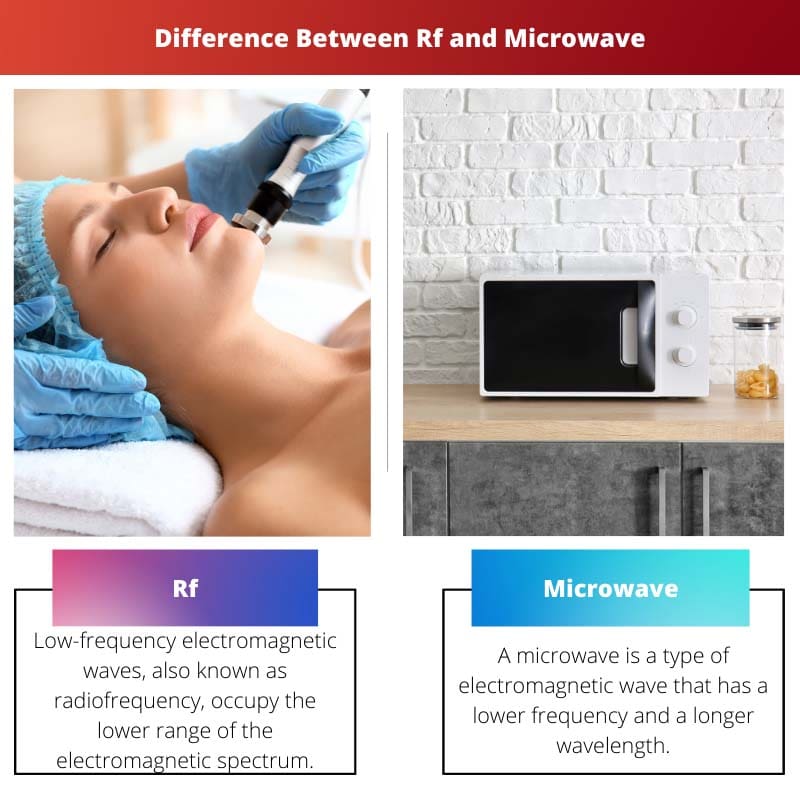Pollution and its consequences are well-known to us. In addition, we are taking a variety of steps to control and overcome them.
When we think of pollution in this context, water, air, and soil come to mind. We’re ignoring a major source of pollution: radiofrequency (rf) and microwave radiation.
We are surrounded by electronic devices and unwittingly encounter these wave energies. The article discusses the differences between these two radiating energies, rf and microwave.
Key Takeaways
- RF (Radio Frequency) and Microwave are both types of electromagnetic radiation used for communication and other purposes.
- RF has a lower frequency and is used for radio and television broadcasting, while Microwave has a higher frequency and is used for telecommunications and microwave ovens.
- RF can travel longer distances with less bandwidth, while Microwave has a shorter range but higher bandwidth.
Rf vs Microwave
RF stands for Radio Frequency, and it is a kind of electromagnetic wave that comes from the lower range in the electromagnetic spectrum, and it’s gotten naturally from the sun. Microwave is a special kind of electromagnetic wave that has a low frequency, and its common in micro-ovens.

Low-frequency waves with longer wavelengths are referred to as Rf. They are found in the lower electromagnetic spectrum.
The electromagnetic spectrum is a collection of waves that can be distinguished by their different frequencies, which range from low to high in time.
They are made up of a combination of radio waves and microwaves. They have a variety of uses, which we will go over shortly.
Microwaves have lower frequencies, so they can’t be ionized. They are non-ionizable if they are unable to ionize an electron within an atom.
That ionization necessitates a higher frequency, whereas microwave requires a lower frequency with a longer wavelength. Our micro-oven, which we use, is one of the most common microwave applications.
Comparison Table
| Parameters of comparison | Rf | Microwave |
|---|---|---|
| Definition | Radiofrequency is a type of electromagnetic wave that originates in the lower range of the electromagnetic spectrum. | The microwave is one of the radiofrequency divisions, and the radio wave is the other. |
| Frequency | 300GHz to 30KHz | 300GHz to 300MHz |
| wavelength | 1mm to 10 km | 1mm to 1m |
| Source | Natural source (sun), artificial (wi-fi, cordless phones, medical instruments). | Micro-oven, heaters, diathermy. |
| Application | Radio (AM/FM), television, mobiles, any wireless connection, and medical appliances. | Satellite, space communication, radar, navigation, and appliances for short-range communication. |
What is Rf?
Low-frequency electromagnetic waves, also known as radiofrequency, occupy the lower range of the electromagnetic spectrum. The electromagnetic spectrum can be visualized.
As a series of electromagnetic waves with varying frequencies and wavelengths, frequency describes how a wave passes through a given point in a given amount of time.
The wavelength, on the other hand, indicates the wave’s width. Frequency increases from left to right while wavelength decreases in an electromagnetic series.
The highest frequency and shortest wavelength are found in X-rays and gamma rays. Rf, or radiofrequency, is divided into radio waves and microwaves.
Every now and then, we unintentionally come into contact with radiofrequency. Because of the radiofrequency (rf) fields that encircle us, this is the case.
Radiofrequency is used to broadcast the television we are watching or the radio we are listening to. Even in the medical field, RF (radiofrequency) has a wide range of applications.
It is used in communication devices due to its long wavelength. Aside from that, high exposure to radiofrequency radiation can have negative consequences because it can emit harmful waves.
To prevent this, ARPANSA established a frequency range of 100KHz to 300GHz, which was published in 2021.
What is Microwave?
A microwave is an electromagnetic wave with a lower frequency and a longer wavelength. The range of frequencies is 300GHz to 300MHz.
Microwaves can be found just after radio waves in the electromagnetic spectrum, which have a lower frequency and longer wavelength than microwaves.
The micro-oven is one of the most common microwave applications. It uses microwaves with a wavelength of around 12cm.
It is mechanized because the interaction of the food molecules with the rotation enforces and produces heat. Microwaves are distinguished from radio waves by their application.
This is due to the fact that their frequency and wavelength vary. Microwaves can be divided into sub-bands within their frequency range.
For example, C-band, S-band, X-band, and Ku band. The C-band can penetrate clouds and reveal information about the earth’s surface due to its medium length.
In GPS, the L-band microwave is used. The C and X bands are commonly used for satellite data monitoring, while the Ku band is used for ground stations.
Microwaves have an interesting wavelength that allows researchers to collect data on satellites because they can penetrate clouds and snow.
It also assists in the collection of hurricane-related information. In addition to active remote sensing, microwaves are used in passive remote sensing.

Main Differences Between Rf and Microwave
- Radiofrequency is a type of electromagnetic wave that originates in the lower range of the electromagnetic spectrum, whereas microwave is one of the radiofrequency divisions, and radio wave is the other.
- The frequency in Rf ranges from 300GHz to 30KHz, whereas microwave ranges from 300GHz to 300MHz.
- The wavelength of Rf is between 1mm to 10 km, whereas microwave ranges from 1mm to 1m.
- Natural sources (sun) and artificial (wi-fi, cordless phones, medical instruments) are a few sources of Rf, whereas sources of microwave include Micro-oven, heaters, and diathermy.
- The applications of Rf are Radio (AM/FM), television, mobiles, any wireless connection, and medical appliances, whereas microwave satellite, space communication, radar, navigation, and appliances are for short-range communication.




